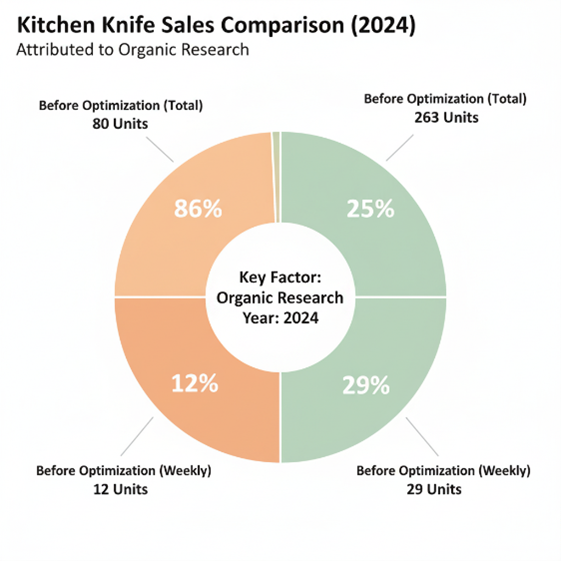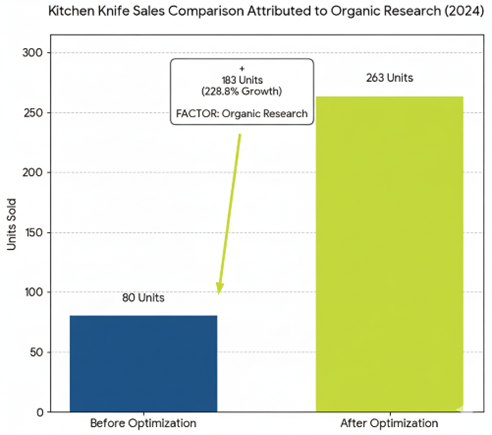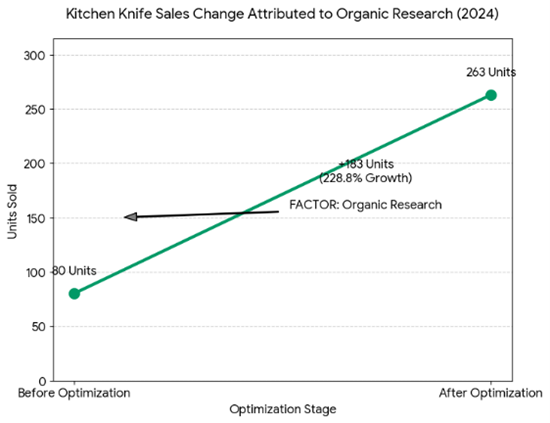Executive summary
This case study examines the strategic revitalization of a Japanese-style High-Carbon Steel Vegetable Cleaver (Nakiri) on amazon. Initially the product struggled to gain traction in a niche but competitive market hampered by an inability to connect with its target audience and justify its premium nature. The product was lost between mass-market knife sets and elite artisanal brands. A comprehensive data driven optimization strategy was deployed focusing on educating the customer building trust in a specialized tool and showcasing the product’s unique value. This led to a dramatic shift in positioning establishing the cleaver as a trusted high value option for discerning home cooks and resulting in significant growth, organic rank conversion rate and overall brand equity.
Before Optimization
- Niche Market Misperception: The listing failed to educate potential buyers on the purpose of a Nakiri knife, leading to high bounce rates from customers unfamiliar with specialized Japanese cutlery.
- Standing Sales Velocity: The product was perceived as just another knife, unable to deliver its premium price point against cheaper generic chef’s knives.
- Low Credibility and Trust: Lack of detailed technical information and amateur visuals raised doubts about the quality of the high-carbon steel (Will it rust?) and the authenticity of the Japanese-style claim.
- Ineffective Imagery and Copy: Product images were small and failed to convey the knife’s craftsmanship, sharpness, and ideal use cases. The title and bullet points were generic and feature-focused, not benefit-driven.
- Poor PPC Performance: High ACoS (Advertising Cost of Sale) due to targeting overly broad terms like kitchen knives which attracted low intent shoppers, rather than focused enthusiasts.


After Optimization
- Specialist in a Niche: The listing successfully educated the market, positioning the Nakiri as the ultimate vegetable preparation tool, thereby justifying its price and reducing comparison with standard knives.
- Rising Organic Search Ranking: Achieved top rankings for high-intent keywords like Japanese vegetable cleaver, Nakiri knife for home cook, and high-carbon steel chef knife.
- Highly Targeted PPC Campaigns: Implemented campaigns targeting specific long tail keywords related to technique and enthusiasts (e.g best knife for julienning, rust-resistant carbon steel) drastically improving conversion rates and lowering ACoS.
- Maximized Impact with A+ Content: Utilized A+ Content modules to provide knife care instructions, detailed steel composition, and a visual guide to different cutting techniques (e.g., julienne, chiffonade), directly addressing key purchase barriers.
- High-Conversion Visual Storytelling: Implemented professional macro photography of the blade’s hammered texture, lifestyle images showing paper-thin cucumber slices and comparison infographics against a standard Western chef’s knife.


Key Factors
- Educational Marketing: The entire listing was transformed into a guide, explaining why a Nakiri is superior for vegetable prep, how to use it and how to care for it. This built immense value and trust.
- Leveraging Social Proof & Review Velocity: Actively solicited reviews from cooking enthusiasts and highlighted user generated content showing perfect cuts. Reviews mentioning sharp, lightweight and game-changer for veggies became powerful social proof.
- Proactive Q&A Section Management: Pre emotively addressed critical concerns about maintenance (How to prevent rust? What sharpener to use?) care, and the difference between a Nakiri and a Usuba, drastically reducing customer hesitation and post purchase returns.
- Strategic Keyword Optimization: Moved beyond generic terms to capture the specific, high-commercial-intent language of the target audience, including heritage knife, precision cutting, and plant based cooking.
SALES COMPARITIVE BY MULTIPLE FACTORS



Following factors which effected the sales and product visualization on amazon is shown, use of effective measurements which has change the value precision of the product in the market. Before applying following strategies, the sales of the following product were change over a short time period with drastic change.
Conclusion
The transformation of this Japanese-style High-Carbon Steel Cleaver from an obscure, underperforming SKU to a recognized authority in its category underscores a critical lesson in Amazon commerce: in specialized niches, success is not just about being found but about being understood. The initial investment in sophisticated content and educational marketing was not merely a listing enhancement it was a fundamental repositioning of the product that created its own market.
This case study proves that for high consideration, specialty items, the listing must act as both a salesperson and an educator. By meticulously addressing the knowledge gap that existed between the product and its ideal customer, the optimization built the necessary trust to justify a premium price point. The journey confirms that in competitive segments on amazon, a generic presentation condemns a product to commodity status and price wars. In contrast a strategically optimized, content rich presence that tells a compelling story and educates the consumer is the most powerful lever for achieving sustainable profitability and long-term brand building. For specialized kitchen tools customer-centric optimization is the definitive factor that separates a struggling listing from a celebrated product.
- Strong branding can create a sense of community among users
- Effective product branding goes beyond functionality and connects with consumers on an emotional level
- Continuously monitor brand performance and customer perceptions
